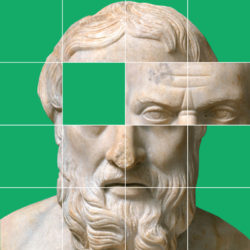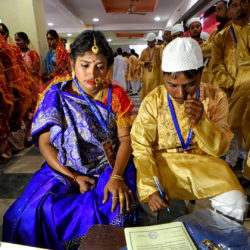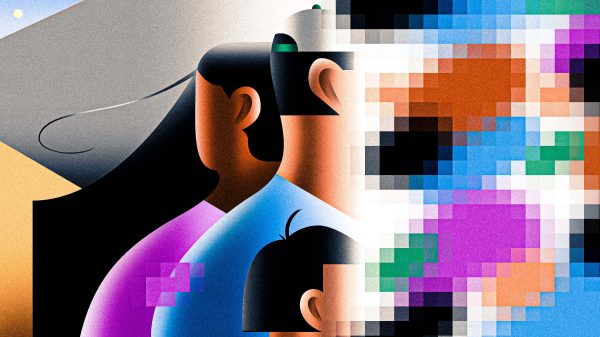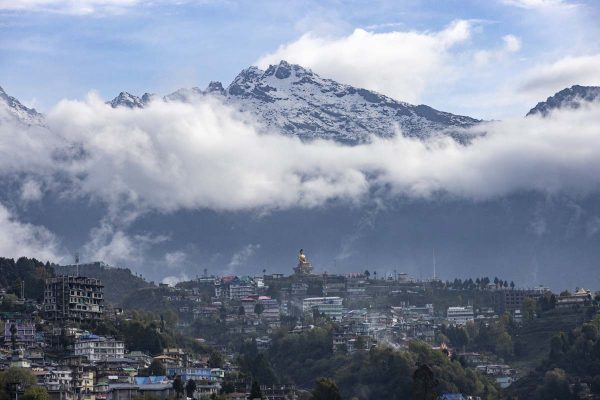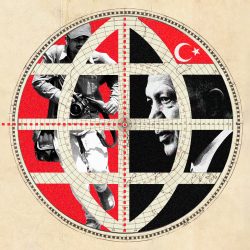
Teona Tsintsadze/Getty Images
The demolition of dissent in India
On April 1, a Saturday morning, a crowd gathered on a Delhi sidewalk as if before a piece of street theater. The police were there in large numbers. And then the stars showed up — a trio of yellow bulldozers. Protected by their police escort, the bulldozers proceeded to demolish a Muslim shrine that was, the shrine’s caretaker said, centuries old.
“My heart started beating faster,” Yusuf Beg, the caretaker, told me, as he described a phone call he had received that morning. For much of the previous month, the city authorities had been asking Beg to raze parts of the shrine. On March 15, he received a letter from the Delhi Public Works Department that claimed the shrine was encroaching on the pavement. He removed some of the construction with his own hands, but it wasn’t enough. “We want the whole pavement cleared,” Beg says the public works department officials told him. On the morning of April 1, Beg received a call to inform him that the bulldozers were on their way.
Sheba Khan, a singer, was among those gathered around the debris where a prayer room once stood. “There are so many illegal constructions in the city,” she told me. Did the authorities really have to come here? What hazard did this particular shrine represent? “It was such a peaceful place,” she said.
Beg was astonished that the bulldozers had been deployed even when he had attempted to cooperate with the authorities. “Tell me,” Beg said, welling up, “did the footpath come first or this 400-year-old shrine?”
Over the past year, the bulldozer has emerged as a symbol of Indian Prime Minister Narendra Modi’s oft-invoked “New India.” The bulldozer is most closely associated not with Modi but with the promise of strong and effective governance offered by Yogi Adityanath. A hard-line Hindu monk clad in saffron robes, Adityanath is the chief minister of Uttar Pradesh, India’s most populous state. With 236 million people, an independent Uttar Pradesh would be about the fifth most populated country in the world. It would also be one of the poorest.
Adityanath became the chief minister of the northern Indian state in 2017 when the Bharatiya Janata Party, Modi’s party, came to power in local elections with an unprecedented mandate. He led the BJP to another landslide victory last year. For many, Adityanath is the biggest star in the BJP after Modi himself. Some even argue that Adityanath is the likeliest candidate to succeed Modi as prime minister. When Adityanath campaigns in states where the BJP contests elections, he draws huge crowds.

On the campaign trail for the Uttar Pradesh elections in 2022, Adityanath held the bulldozer up as an exemplar of stern action and swift justice in the face of a slow legal system. In his stump speeches, Adityanath declared that if he were voted back into office, he would use the bulldozer against “criminals,” “mafias” and “rioters.” His government had first used a bulldozer in 2020 to knock down the house of a notorious gangster, who was alleged to have killed eight policemen. The gangster himself was later killed in a “police encounter,” an Indian euphemism for what is effectively an extrajudicial execution.
The bulldozer was, supposedly, the evidence of Adityanath’s zero-tolerance approach to crime. It struck a chord with the people in Uttar Pradesh, and they hailed him as the “Bulldozer Baba.” In March 2022, with the election handily won, Adityanath’s ecstatic supporters waved BJP flags as they rolled down the streets across the state in bulldozers.

But the bulldozer is not simply a neutral symbol of a strong state reclaiming land from encroachers or taking on hardened criminals. Adityanath’s election speeches were replete with anti-Muslim rhetoric, with the Muslim community associated with “rioters” and referred to as “Taliban” supporters. As the bulldozer emerged as an unofficial election mascot for BJP-style tough governance, the subtext was clear: The criminals Adityanath wanted to go after would primarily be found outside the middle-class Hindu majority.
Since Adityanath’s reelection as the Uttar Pradesh chief minister in 2022, he has deployed bulldozers in the aftermath of protests, razing homes of those who have only been accused, not convicted, of rioting. “Mere alleged involvement in criminal activity cannot ever be grounds for demolition of property,” said AP Shah, a former chief justice of the Delhi High Court. No due process is being followed, he told me. The bulldozer has become “a symbol of repression and oppression of the poor and marginalized and has ruined entire families.”
Critics have pointed out that Adityanath has used bulldozers disproportionately to demolish the homes of Muslims, a pattern that has been repeated in BJP-administered states such as Gujarat and Madhya Pradesh. The pretext most often used is the clearing of illegal encroachments and construction. Aakar Patel, the chair of Amnesty International’s India board, said that home demolitions are used to “inflict punishment on the community for raising their voices.” Several human rights experts told me this amounts to an abuse of the law. The bulldozer, they say, is being used to silence, and “instill fear” in, Muslim communities following protests or communal violence in an India that has been perceived as stridently sectarian since Narendra Modi became prime minister in 2014. The Uttar Pradesh government denies this reading. Rakesh Tripathi, a BJP spokesman in Uttar Pradesh, told me that the government goes after all criminals and encroachments, not just Muslims.
Angshuman Choudhury, an associate fellow at the Delhi-based Center for Policy Research, described Adityanath’s use of the bulldozer as a “primordial form of justice delivery.” It was, he said, a “leaf right out of the textbook of populism.” The bulldozer gives the majority a sense of safety, a belief that the government is taking quick action against purported criminals, even if that definition is extended to include anyone the state deems an enemy. “Just give the majority what it wants,” he told me, that is what Adityanath’s use of bulldozers amounted to. “And what the majority wants is quick justice.”

So popular has the bulldozer become in the growing iconography of Hindu nationalism that young men have been lining up to get bulldozers inked onto their skin. Abhinav Kumar, the owner of BlackJack Tattoo Studio in Lucknow, the capital of Uttar Pradesh, told me that several people had come to him asking for bulldozer tattoos during a time when the tattoo was “trending.” This was in the aftermath of Adityanath’s election victory and during periods when there were a series of high-profile demolitions in the news. Bulldozers have also featured on packets of local snacks and in several Hindu nationalist pop songs.
In Modi’s India, the bulldozer is evolving as a new cultural symbol, normalized as part of India’s political and Hindu nationalist lexicon. It is a shorthand for the Modi regime’s carefully crafted muscular identity, its suppression of minorities and its narrative of a formidable, resurgent Hindu India under his leadership. The bulldozer has transcended politics, Choudhury said, to become an “element of pop culture” that the public could consume.
The bulldozer as a calling card of a confident Hindu nationalism has made its way, inevitably, to countries with large Indian diasporas. In an Indian Independence Day parade in Edison, New Jersey in August 2022, a vehicle that resembled a bulldozer was among the floats. Sambit Patra, a BJP national spokesman in India, attended as a guest of honor. The parade was organized by a local organization of diaspora businessmen called the Indian Business Association.
“It was shocking,” Ria Chakrabarty, the policy director for Hindus for Human Rights, a progressive nonprofit in the U.S., told me about the bulldozer’s inclusion in the parade. It was well known, she said, that there was sympathy for Hindu nationalism within the Indian diaspora, “but I don’t think I expected such fervent support.” Chakraborty said Hindus for Human Rights was engaged in “educating U.S. lawmakers” on why the bulldozer “has become a harmful symbol” for Muslims in India. “We view it as a symbol of hate,” she said, adding that “all the toxicity of Indian politics was now seeping into Indian-American politics.”
Eventually, the organizers of the parade were forced to apologize. In a letter on August 30, the Indian Business Association acknowledged that the bulldozer was a “divisive image” and that its inclusion in the parade had “offended Indian American minority groups, especially Muslims.” Shortly after, on September 2, Cory Booker and Bob Menendez, U.S. senators from New Jersey, released a joint statement describing the bulldozer as “a symbol of intimidation against Muslims and other religious minorities in India.”
Audrey Truschke, an associate professor of South Asian History at Rutgers University, told me that “Muslims are increasingly treated as second-class citizens in India’s autocracy.” By “using bulldozers to illegally destroy Muslim homes,” she said, “the BJP sends a clear message to this religious minority: Be afraid.” Outside India, Truschke’s interpretation of Adityanath’s bulldozer justice is widely accepted as accurate.
In June 2022, three United Nations special rapporteurs wrote to the Indian federal government, expressing “serious concern” about the “forced evictions and arbitrary home demolitions carried out against Muslim communities and other low-income groups in India.” The letter referred to demolitions in Madhya Pradesh, Gujarat and Delhi as having a “distinct ‘punitive’ nature,” and said that they appeared “to have been carried out as collective punishment against the minority Muslim community.” The letter also described the act as a “violation of international human rights standards.” The language is strikingly reminiscent of language the U.N. has used to describe the “punitive demolitions” inflicted by Israeli authorities on Palestinians in the occupied territories. “In short,” a U.N. special rapporteur said back in 2014, “punitive home demolitions are an act of collective punishment that contravenes international law.”
Angshuman Choudhury, at the Center for Policy Research in Delhi, told me that there was an “uncanny similarity between the modus operandi of the Hindu nationalist Modi government and how the Israeli state has been conducting itself in Palestine.” Under the leadership of Benjamin Netanyahu, demolitions of Palestinian homes have risen sharply. Last month, the U.N. noted the demolition of nearly double the number of structures in East Jerusalem since Netanyahu returned to power in late December than during the equivalent period the previous year.
While he notes the different political context in Israel and that state’s use of demolitions as part of a “territorial expansion,” Choudhury argues that just as Israel has used bulldozers as retribution against individual Palestinians, so India uses them to “create a chilling effect and punish Muslims who dare to protest.”
Thomas Blom Hansen, an anthropologist and professor of South Asian studies at Stanford University, told me that the Hindu nationalist movement “has long been admiring Israel and the Zionist movement that makes Israel into a privileged home for all Jews in the world.” He says he’s heard personally from many Hindu nationalists who “have conveyed that sense of admiration to me and have told me that they thought India should be a home to Hindus only.”
This explains the popular embrace and the cultural celebration — at least in the country’s largely Hindi-speaking heartland — of the bulldozer as a symbol of the BJP’s might and its belligerence.
Hansen told me that the bulldozer represents “a new phase in the Hindu nationalist project.” The celebration of the bulldozer, he says, is “a form of payback, a revenge fantasy” for perceived injustices suffered by Hindus under the Muslim Mughal empire that controlled much of India for hundreds of years until the British took over in the mid-19th century. Demolitions, he argues, provide “great entertainment and collective satisfaction,” comparing it to the “jeering and cheering crowds at lynchings in the American South, or all those ordinary people who celebrated antisemitic pogroms in Europe.”

Adityanath and the BJP’s claim that the bulldozer is a means to deter criminals and reclaim government land is largely disingenuous. In June 2022, India’s Supreme Court told the Yogi Adityanath government that demolitions “cannot be retaliatory” but the judges still refused to step in and stop the use of bulldozers. To avoid serious judicial scrutiny, the government justifies the demolitions by claiming that the properties being destroyed are illegal constructions.
Hansen, the Stanford professor, told me that the “BJP more or less exercises its power with complete impunity, that it is beyond the accountability of the law.” The “potency” of the bulldozer as a symbol, he said, lies in the fact that it supposedly upholds the law and is an “enforcement of order.” Bulldozers have traditionally been used in India in the “name of urban development and disciplining the poor.” There is “strong support for such punitive measures against the poor and social and religious minorities among the middle classes,” who enjoy the benefits of more regularized and formal housing. Given the extent of unauthorized building in Indian cities, though, a vast number of buildings are vulnerable to being declared illegal. “Nothing is easier,” Hansen told me, than to “find formal problems with most buildings if the authors so desire,” making the discretionary powers of the state “wide open to abuse and the blatant harassment of certain individuals and communities.”
Much of this abuse was evident when the Adityanath government lashed out at protesters last summer. On the morning of June 12, 2022, Afreen Fatima, a former student at the prestigious Jawaharlal Nehru University, saw her family home being torn down. “I watched it live on YouTube,” she told me. As Fatima witnessed the demolition of the home she had lived in for 20 years, her mother prayed on a mat nearby.
With police in riot gear stationed outside, three bulldozers were put to work destroying Fatima’s house. The media, present in droves, broadcast the demolition across the country. Fatima and her father had been vocal critics of the Modi government. “It was an act of vendetta,” Fatima told me about the Adityanath government’s actions. Her father had been picked out as a protest “ringleader” after two BJP members, one a party spokesperson, made offensive remarks about the Prophet Muhammad on television, leading to days of unrest in India and a sharp diplomatic backlash, especially from the Gulf countries where many Indian migrants work. The demonstrations turned violent in some places, with incidents of stone-pelting and arson. Fatima denied that her father had led the protests, but it made no difference.
Fatima believes the bulldozer sends a message to the Hindus that the BJP government is “showing Muslims their place” and a message to the Muslims to “stay in line.” She told me she believes the bulldozer demolitions have had their desired effect. “The way the Muslim community earlier asserted its presence in public spaces,” she said, “has changed. Now, it’s like let’s just survive one day at a time.”After the demolition, Fatima’s family found it hard to find a place to live. Landlords did not want to rent to them. They were afraid, Fatima said. “Our entire family was criminalized,” she told me, “to the extent that people were scared to talk to us on the phone.”

Photo by SANJAY KANOJIA/AFP via Getty Images.
Despite criticism at home and abroad, the BJP appears to be expanding its punitive use of the bulldozer. In February, a mother and daughter were killed in a village in Uttar Pradesh during an anti-encroachment drive, the widely used term in India for clearing illegal buildings and developments. The family said that officials showed up, bulldozer in tow, and ended up setting fire to the family’s hut. The authorities claimed that the mother and daughter locked themselves in the hut and set fire to it.
Also in February, the government launched an anti-encroachment drive in the disputed Indian state of Kashmir, a site of territorial conflict with Pakistan and a decades-long insurgency. Kashmir is currently heavily controlled, with little independent reporting permitted and with journalists and critics frequently jailed even as the BJP insists that peace has been established in the Valley. The government reclaimed 50,000 acres of land during the demolition drive before the bulldozers were temporarily called off as people in India’s only Muslim-majority state became increasingly panicked and angered.
On April 1, in Delhi’s Nizamuddin neighborhood, after the bulldozers moved in and tore down most of the old Muslim shrine, the tombs of the saint and his family lay in the open air, covered only by a thin, lime-green sheet and surrounded by stone debris. The March 15 letter from the public works department specifically mentioned removing the encroachments as soon as possible with the upcoming G-20 summit in mind. World leaders will arrive in India’s capital in September 2023 for a meeting that will mark the end of the country’s year-long G-20 presidency. It is an opportunity, says the BJP, to showcase Indian democracy and development. To that end, a project is ongoing to “beautify” the city of Delhi.
But on that Saturday afternoon, the street looked more disfigured than it had before the bulldozers arrived.
The story you just read is a small piece of a complex and an ever-changing storyline that Coda covers relentlessly and with singular focus. But we can’t do it without your help. Show your support for journalism that stays on the story by becoming a member today. Coda Story is a 501(c)3 U.S. non-profit. Your contribution to Coda Story is tax deductible.



